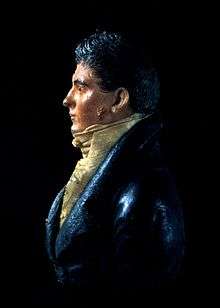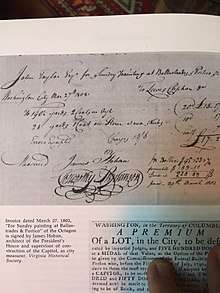James Hoban
James Hoban (1755[1] – December 8, 1831) was an Irish architect, best known for designing the White House in Washington, D.C.

Life
James Hoban was an Irish Catholic raised on an estate belonging to the Earl of Desart in Callan, County Kilkenny. He worked there as a wheelwright and carpenter until his early twenties, when he was given an 'advanced student' place in the Dublin Society's Drawing School on Lower Grafton Street. He studied under Thomas Ivory.[2] He excelled in his studies and received the prestigious Duke of Leinster's medal for drawings of "Brackets, Stairs, and Roofs" from the Dublin Society in 1780. Hoban was an apprentice to Ivory, from 1779 to 1785.
Following the American Revolutionary War, Hoban emigrated to the United States, and established himself as an architect in Philadelphia in 1785.[3]
_HABS361451pv.jpg)


Hoban was in South Carolina by April 1787, where he designed numerous buildings including the Charleston County Courthouse (1790–92), built on the ruins of the former South Carolina Statehouse (1753, burned 1788).[4] President George Washington admired Hoban's work on his Southern Tour, Washington may have met with him in Charleston in May 1791, and summoned the architect to Philadelphia, Pennsylvania (the temporary national capital) in June 1792.[5]
In July 1792, Hoban was named winner of the design competition for the White House.[6] His initial design seems to have had a 3-story facade, nine bays across (like the Charleston courthouse). Under Washington's influence, Hoban amended this to a 2-story facade, 11 bays across, and, at Washington's insistence, the whole presidential mansion was faced with stone. It is unclear whether any of Hoban's surviving drawings are actually from the competition.[7]
It is known that Hoban owned at least three slaves who were employed as carpenters in the construction of the White House. Their names are recorded as "Ben, Daniel, and Peter" and appear in a James Hoban slave payroll.[8]
Hoban was also one of the supervising architects who served on the Capitol, carrying out the design of Dr. William Thornton, as well as with The Octagon House. Hoban lived the rest of his life in Washington, D.C., where he worked on other public buildings and government projects, including roads and bridges.[9]
Local folklore has it that Hoban designed Rossenarra House near the village of Kilmoganny in County Kilkenny, Ireland in 1824.[10]
Hoban's wife Susanna Sewall was the daughter of the prominent Georgetown "City Tavern" proprietor.[11][12]
After the District of Columbia was granted limited home rule in 1802, Hoban served on the twelve-member city council for most of the remainder of his life, except during the years he was rebuilding the White House.[13] Hoban was also involved in the development of Catholic institutions in the city, including Georgetown University (where his son was a member of the Jesuit community), St. Patrick's Parish, and the Georgetown Visitation Monastery founded by another Kilkenny native, Teresa Lalor of Ballyragget.
Hoban died in Washington, D.C., on December 8, 1831. He was originally buried at Holmead's Burying Ground,[14] but was disinterred and reburied at Mount Olivet Cemetery in Washington, D.C. His son James Hoban, Jr., said to be the spitting image of his father, served as district attorney of the District of Columbia.[13]
Work
Little has been published to catalogue Hoban's architectural work.
- Charleston County Courthouse, 82-86 Broad Street, Charleston, SC (1790–92).[15] Both this building and the White House were modeled on Leinster House, the current Irish Parliament Building, that in the 18th century was the home of the Gaelic Norman Fitzgerald Family, Earls of Kildare.
- The White House, 1600 Pennsylvania Avenue, Washington, D.C. - (1792–1800). Following the 1814 burning of the White House, Hoban rebuilt the Southern Portico for President James Monroe (1824), and the Northern Portico for President Andrew Jackson (1829).
- The Octagon House, 1799 New York Ave, Washington DC (1802)
Attributed buildings
- "Prospect Hill" (Ephraim Baynard mansion), Prospect Hill Plantation, 2695 Laurel Hill Road, Edisto Island, SC 29438 - circa 1790.[16][17] (Attributed to Hoban.)
- First Bank of the United States, Third Street, between Chestnut and Walnut Streets, Philadelphia, PA - 1795.[18][19] (Samuel Blodgett is the credited designer, but some attribute it to James Hoban.)
- McCleery House, 1068 Thirtieth St. NW, Georgetown, Washington, DC, c. 1800.[20] (With many fine significant interior details, reportedly designed by James Hoban.)
- The William Seabrook House, Edisto Island, SC - completed 1810.[21] (Attributed to Hoban.)
- "Baum-Taft House (Taft Museum of Art), 316 Pike Street, Cincinnati, OH - 1820.[22] (Attributed to Hoban.)
- Oak Hill (James Monroe House) (President James Monroe mansion), in Aldie, Virginia - 1820. (Monroe sought the advice of both Hoban and Thomas Jefferson on the design of his mansion.)[23]
- Rossenarra House, near the village of Kilmaganny, Ireland - 1824. (Attributed to Hoban).
- Belcamp House - Belcamp College, Malahide road, Dublin 17, Built complete with "oval office" . The college was Established around it in 1893 as a juniorate for the Oblate Fathers, It was built onto the original house but the house still stands intact today. A mini White House, and an overlooked piece of history.
Demolished buildings
- Blodget's Union Public Hotel (a.k.a. Blodget's Lottery Hotel), site of the first General Post Office of the United States, northeast corner of 8th and E Streets, Washington, D.C. - 1783 (Demolished in 1856)[24]
- Wye Hall (John Paca mansion), Wye Island directly opposite Wye Plantation, Maryland - circa 1787 (Demolished 1789)[25]
- South Carolina State House, Columbia, S.C. - 1790 (burned 1865)[26][27]
- The Charleston Theatre, New and Broad Streets, Charleston, S.C. - 1792 (Demolished)[28]
- Northeast Executive Building, Fifteenth Street, near The White House (Demolished)
- Market House (a.k.a. "Marsh Market"), Pennsylvania Avenue and Seventh Street, Washington, D.C. - 1801 (Demolished)
- St. Patrick’s Church, Corner of 14th and H Streets, NW, Washington, D.C. (Demolished. Now the site of the old Grand Lodge building)
- St Mary's Chapel (a.k.a. Barry's Chapel), Roman Catholic parish church, 10th and F Streets, Washington, D.C. - 1806 (Demolished; its cornerstone was saved, and is now inserted in the outer wall of the Holy Name Chapel, the Church of St. Dominic.)
Commemorations
Numerous events were held around 2008 to commemorate the 250th anniversary of his birth.
In 2008, a memorial arbor to honor James Hoban was completed near his birthplace, and a major exhibition on his life took place at the White House Visitor Center.[29]
Dublin Made Him..., a one-day colloquium in honour of Hoban, took place on October 3, 2008, at the (RDS) in Dublin, Ireland.[30] It was presented by the RDS in association with the White House Historical Association, the U.S. Embassy in Ireland, and the James Hoban Societies of the U.S. and Ireland.
The Irish-American group Solas have a song "John Riordan's Heels/The Bath Jig/Hoban's White House" on their album For Love and Laughter. Group member Mick McAuley, like Hoban, is from Kilkenny, and named the song in Hoban's honor.
See also
- John Henry Devereux South Carolina architect
- List of people on stamps of Ireland
- White House
- Pedro Casanave
References
- "Free online access to treasure trove of Irish parish records". 1 March 2016. Retrieved 1 March 2016.
- Birse, Ronald M. "Hoban, James". Oxford Dictionary of National Biography (online ed.). Oxford University Press. doi:10.1093/ref:odnb/45956. (Subscription or UK public library membership required.)
- Frary, page 27
- History of the Charleston County Courthouse from HMdb.org
- William Seale, "James Hoban: Builder of the White House" in White House History no. 22 (Spring 2008), pp. 8-12.
- Bryan, page 194–195.
- Commissioners of the District of Columbia, Record Group 42, National Archives, cited in Seale, pp. 10-16.
- https://www.whitehousehistory.org/photos/photo-2-4
- Frary, page 28.
- "Current Biography Yearbook 1989". 1990. p. 120.
- "City Tavern Club V2's Tenant Handbook:History of the Club". 72.32.212.225. 17 January 1981. Archived from the original on 26 April 2012. Retrieved 1 November 2012.
- "Playing with knives and fire - Biography of Mrs. James Hoban - Susanna Sewell". Ren-flora.livejournal.com. 14 February 2008. Retrieved 1 November 2012.
- James Hoban, Architect of the White House: Civic Contributions and Family, White House Historical Association
- Ridgely 1908, p. 259.
- Historic American Buildings Survey (HABS) No. SC-131, "Charleston County Courthouse"
- National Register Form
- Edisto Island 1663 to 1860: Wild Eden to Cotton Aristocracy, Charles Spencer; p. 159
- Baigell, Matthew (May 1969). "James Hoban and the First Bank of the United States". Journal of the Society of Architectural Historians. 28 (2): 135–136. JSTOR 988511.
- American architecture 1607-1976, Marcus Whiffen, Frederick Koeper, p. 125
- Historic American Buildings Survey (HABS) No. DC-162, "McCleery House"
- Edisto: A Guide to Life on the Island, Cantey Wright; p. 35-37 (with photographs)
- TR and Will; A Friendship that Split the Republican Party, by William Manners; p. 335
- "Oak Hill". Nps.gov. Retrieved 1 November 2012.
- Keim's Illustrated Hand-book: Washington and Its Environs, De Benneville Randolph Keim, p. 153
- Maryland: A Guide to the Old Line State, Writers' Program of the Work Projects Administration in the State of Maryland. p. 418
- The Encyclopedia Americana: The International Reference Work, Volume 7; p. 336
- Columbia: History of a Southern Capital, Lynn Salsi, Margaret Sims; p, 27
- The Buildings of Charleston: A Guide to the City's Architecture, Jonathan H. Poston, p. 321
- "The James Hoban Colloquium and Official Opening of the James Hoban Memorial Arbor, October 3–5, 2008". The James Hoban Commemoration. Archived from the original on 2010-04-21.
- Royal Dublin Society
Bibliography
- Ridgely, Helen West (1908). Historic Graves of Maryland and the District of Columbia, With the Iappearing on the Tombstones in Most of the Counties of the State and in Washington and Georgetown. New York: Grafton Press.CS1 maint: ref=harv (link)
Further reading
- Bergin, Denis (2008). "The James Hoban Commemoration 2008". Archived from the original on 2008-05-10. Retrieved 2008-05-06.
- Bryan, Wilhelmus Bogart (1914). "A History of the National Capital". The Macmillan company: 194. Retrieved 2008-01-17.
james hoban superintendent.
Cite journal requires|journal=(help) - Frary, Ihna Thayer (1969). They Built the Capitol. Ayer Publishing. ISBN 0-8369-5089-5.
- Ravenel, Beatrice St. Julien (1904-1990); Julien, Carl (photographs); Carolina Art Association (1992). Architects of Charleston. Columbia, S.C.: University of South Carolina Press. p. 295. ISBN 0-87249-828-X. LCCN 91034126.
- Wells, John E.; Dalton, Robert E. (1992). The South Carolina architects, 1885–1935: a biographical dictionary. Richmond, Virginia: New South Architectural Press. ISBN 1-882595-00-9.